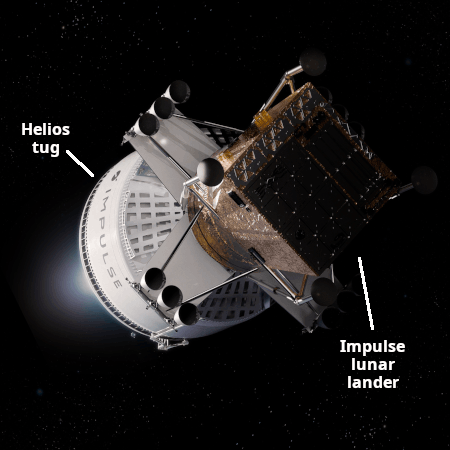Orbital tug startup Impulse Space to develop its own unmanned lunar lander
The orbital tug startup Impulse Space, founded by Tom Mueller (one of SpaceX’s first engineers), is now proposing to build its own unmanned lunar lander, with a target for delivering six tons of cargo on two missions, starting in 2028.
Our proposed architecture combines our existing Helios kick stage and a new lunar lander, to be developed by our team in-house. Helios would launch on a standard medium- or heavy-lift rocket. Our lunar lander would ride as a payload on Helios. Once Helios and the lander are deployed in Low Earth Orbit (LEO), Helios serves as a cruise stage, transporting the lander to low lunar orbit within one week. The lunar lander then separates from Helios and descends to the surface of the Moon. By taking advantage of Helios’s high delta-v capabilities, this mission architecture doesn’t require in-space refueling.
This solution can bridge the existing cargo delivery gap by offering direct transportation of the necessary mass to kickstart infrastructure, resource utilization, and economic activities on the Moon. We’ve already begun engine development for our lunar lander solution, and we stand ready to execute as dictated by industry demand and interest.
With this Helios and Impulse-made lander combination, we estimate delivering up to 6 tons of payload mass to the Moon (across two missions) per year starting in 2028 at a cost-effective price point. Each Helios + lander combo would take approximately 3 tons of cargo to the Moon.
It appears the company has identified a need (transporting cargo to the Moon cheaply and quickly) that no one (including NASA) is presently considering. SpaceX will be able to do it with Starship. Blue Origin is also proposing to do it with various versions of its Blue Moon manned lander. Impulse has decided however that both of those spacecraft are too large and tied to SLS and Lunar Gateway, with Starship requiring refueling, that makes their cargo missions more costly than a direct mission. Impulse proposes a simpler option.
This decision is also another indication that the demand for low orbital tugs is not developing as expected. It appears satellite companies and the available rocket companies have worked out ways to get most of their satellites to the orbits they require without tugs.
It will be interesting to watch if this proposal gains traction. If it does, than it will likely encourage other orbital tug as well as the other lunar lander companies to propose their own alternatives.
The orbital tug startup Impulse Space, founded by Tom Mueller (one of SpaceX’s first engineers), is now proposing to build its own unmanned lunar lander, with a target for delivering six tons of cargo on two missions, starting in 2028.
Our proposed architecture combines our existing Helios kick stage and a new lunar lander, to be developed by our team in-house. Helios would launch on a standard medium- or heavy-lift rocket. Our lunar lander would ride as a payload on Helios. Once Helios and the lander are deployed in Low Earth Orbit (LEO), Helios serves as a cruise stage, transporting the lander to low lunar orbit within one week. The lunar lander then separates from Helios and descends to the surface of the Moon. By taking advantage of Helios’s high delta-v capabilities, this mission architecture doesn’t require in-space refueling.
This solution can bridge the existing cargo delivery gap by offering direct transportation of the necessary mass to kickstart infrastructure, resource utilization, and economic activities on the Moon. We’ve already begun engine development for our lunar lander solution, and we stand ready to execute as dictated by industry demand and interest.
With this Helios and Impulse-made lander combination, we estimate delivering up to 6 tons of payload mass to the Moon (across two missions) per year starting in 2028 at a cost-effective price point. Each Helios + lander combo would take approximately 3 tons of cargo to the Moon.
It appears the company has identified a need (transporting cargo to the Moon cheaply and quickly) that no one (including NASA) is presently considering. SpaceX will be able to do it with Starship. Blue Origin is also proposing to do it with various versions of its Blue Moon manned lander. Impulse has decided however that both of those spacecraft are too large and tied to SLS and Lunar Gateway, with Starship requiring refueling, that makes their cargo missions more costly than a direct mission. Impulse proposes a simpler option.
This decision is also another indication that the demand for low orbital tugs is not developing as expected. It appears satellite companies and the available rocket companies have worked out ways to get most of their satellites to the orbits they require without tugs.
It will be interesting to watch if this proposal gains traction. If it does, than it will likely encourage other orbital tug as well as the other lunar lander companies to propose their own alternatives.

